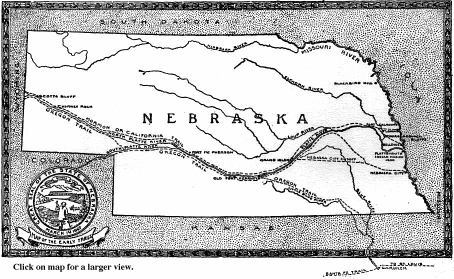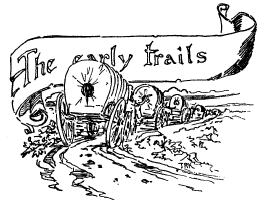
Map of Oregon, Mormon and California Trails. |
|
Indian Trails Became Roadways |
|
|
|
|
|
|
"I will send a Prophet to you, |
|
|
|

|
|
|
56 |
|
|
|
|
Platte river, crossed the South Platte near the present
site of Megeath, west of Ogalalla, and upon reaching the
south bank of the North Platte followed it to Fort Laramie
beyond the state line. |
|
|
|
|
57 |
|
|
and as the sun illuminated the western sky, they lifted
the American flag and with the Bible in the center, they
knelt and with prayer and praise, took possession of the
western side of the American continent in His name who
proclaimed "Peace on earth, good will to men." |
|
|
58 |
|
|
|
|
sought their fortunes in the great wilderness had many
thrilling experiences with Indians, wild animals and
bandits, who were lurking to destroy life and steal their
cattle. |
|
|
|
|
59 |
|
|
led them westward, following the north bank of the Platte
River, making the Mormon trail parallel with the Oregon
trail on the south. Markers are being placed along the
trails. Contributed by Mrs. Edgar Allen. |
|
 |
 |
 |
MARDOS COLLECTION
© 1999, 2000, 2001 for the NEGenWeb Project by Pam Rietsch,
T&C Miller